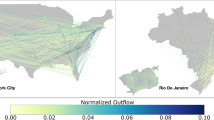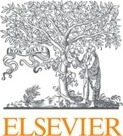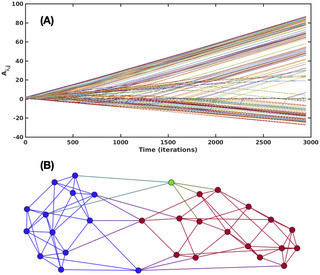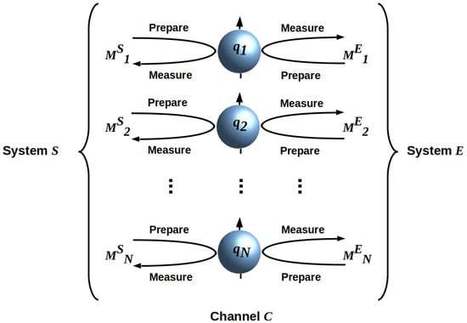 Your new post is loading...
 Your new post is loading...
Xiaofan Liang, César A. Hidalgo, Pierre-Alexandre Balland, Siqi Zheng, Jianghao Wang Computers, Environment and Urban Systems Volume 109, April 2024, 102092 Urban outputs, from economy to innovation, are known to grow as a power of a city's population. But, since large cities tend to be central in transportation and communication networks, the effects attributed to city size may be confounded with those of intercity connectivity. Here, we map intercity networks for the world's two largest economies (the United States and China) to explore whether a city's position in the networks of communication, human mobility, and scientific collaboration explains variance in a city's patenting activity that is unaccounted for by its population. We find evidence that models incorporating intercity connectivity outperform population-based models and exhibit stronger predictive power for patenting activity, particularly for technologies of more recent vintage (which we expect to be more complex or sophisticated). The effects of intercity connectivity are more robust in China, even after controlling for population, GDP, and education, but not in the United States once adjusted for GDP and education. This divergence suggests distinct urban network dynamics driving innovation in these regions. In China, models with social media and mobility networks explain more heterogeneity in the scaling of innovation, whereas in the United States, scientific collaboration plays a more significant role. These findings support the significance of a city's position within the intercity network in shaping its success in innovative activities. Read the full article at: www.sciencedirect.com
Joshua C. Yang, Marcin Korecki, Damian Dailisan, Carina I. Hausladen, Dirk Helbing This paper investigates the voting behaviors of Large Language Models (LLMs), particularly OpenAI's GPT4 and LLaMA2, and their alignment with human voting patterns. Our approach included a human voting experiment to establish a baseline for human preferences and a parallel experiment with LLM agents. The study focused on both collective outcomes and individual preferences, revealing differences in decision-making and inherent biases between humans and LLMs. We observed a trade-off between preference diversity and alignment in LLMs, with a tendency towards more uniform choices as compared to the diverse preferences of human voters. This finding indicates that LLMs could lead to more homogenized collective outcomes when used in voting assistance, underscoring the need for cautious integration of LLMs into democratic processes. Read the full article at: arxiv.org
Timur Abbiasov, Cate Heine, Sadegh Sabouri, Arianna Salazar-Miranda, Paolo Santi, Edward Glaeser & Carlo Ratti
Nature Human Behaviour (2024) Amid rising congestion and transport emissions, policymakers are embracing the ‘15-minute city’ model, which envisions neighbourhoods where basic needs can be met within a short walk from home. Prior research has primarily examined amenity access without exploring its relationship to behaviour. We introduce a measure of local trip behaviour using GPS data from 40 million US mobile devices, defining ‘15-minute usage’ as the proportion of consumption-related trips made within a 15-minute walk from home. Our findings show that the median resident makes only 14% of daily consumption trips locally. Differences in access to local amenities can explain 84% and 74% of the variation in 15-minute usage across and within urban areas, respectively. Historical data from New York zoning policies suggest a causal relationship between local access and 15-minute usage. However, we find a trade-off: increased local usage correlates with higher experienced segregation for low-income residents, signalling potential socio-economic challenges in achieving local living. Read the full article at: www.nature.com
Tazzio Tissot, Mike Levin, View Chris Buckley, Richard Watson How do multiple active components at one level of organisation create agential wholes at higher levels of organisation? For example, in organismic development, how does the multi-scale autonomy of the organism arise from the interactions of the molecules, cells and tissues that an organism contains? And, in the major evolutionary transitions, how does a multicellular organism, for example, arise as an evolutionary unit from the selective interests of its unicellular ancestors? We utilise computational models as a way to think about this general question. We take a deliberately minimalistic notion of an agent: a competency to take one of two possible actions to minimise stress. Helping ourselves to this behaviour at the microscale, we focus on conditions where this same type of agency appears spontaneously at a higher level of organisation. We find that a simple process of positive feedback on the timing of individual responses, loosely analogous to the natural phase synchronisation of weakly coupled oscillators, causes such a transition in behaviour. The emergent collectives that arise become, quite suddenly, able to respond to their external stresses in the same (minimal) sense as the original microscale units. This effects a dramatic rescaling of the system behaviour, and a quantifiable increase in problem-solving competency, serving as a model of how higher-level agency emerges from a pool of lower-level agents or active matter. We discuss how this dynamical ‘waking-up’ of higher-level collectives, through the alignment of their internal dynamics, might relate to reproductive/cell-cycle synchronisation in evolutionary transitions and development. Read the full article at: www.biorxiv.org
Daniel Hoyer, Samantha Holder, James S Bennett, Pieter François, Harvey Whitehouse, Alan Covey, Gary Feinman, Andrey Korotayev, Vadim Vustiuzhanin, Johannes Preiser-Kapeller, Kathryn Bard, Jill Levine, Jenny Reddish, Georg Orlandi, Rachel Ainsworth, and Peter Turchin Societal ‘crises’ are periods of turmoil and destabilization in socio-cultural, political, economic, and other systems, often accompanied by varying amounts of violence and sometimes significant changes in social structure. The extensive literature analyzing societal crises has concentrated on relatively few historical examples (large-scale events such the fall of the Roman Empire or the French and Russian Revolutions) emphasizing different aspects of these events as potential causes or consistent effects. To investigate crises and prior approaches to explaining them, and to avoid a potential small-sample size bias present in several previous studies, we sought to uniformly characterize a substantial collection of historical crises, spanning millennia, from the prehistoric to post-industrial, and afflicting a wide range of polities in diverse global regions; the Crisis Database (CrisisDB). Here, we describe this dataset which comprises 168 crises suggested by historians and characterized by a number of significant 'consequences' (such as civil war, epidemics, or loss of population) including also institutional and cultural reforms (for example improved sufferance or constitutional changes) that might occur during and immediately following the crisis period. Our analyses show that the consequences experienced by each crisis is highly variable. The outcomes themselves are uncorrelated with one another and, overall, the set of consequences is largely unpredictable when compared to other large-scale properties of society suggested by previous scholars such as its territorial size, religion, administrative size, or historical recency. We conclude that there is no ‘typical’ societal crisis of the past, but crisis situations can take a variety of different directions. We offer some suggestions on the forces that might drive these varying consequences for exploration in future work. Read the full article at: osf.io
R Alexander Bentley, Benjamin Horne, Joshua Borycz, Simon Carrignon, Garriy Shteynberg, Blai Vidiella, Sergi Valverde, and Michael J O’Brien Adaptive Behavior Volume 32, Issue 2 Diversity of expertise is inherent to cultural evolution. When it is transparent, diversity of human knowledge is useful; when social conformity overcomes that transparency, “expertise” can lead to divisiveness. This is especially true today, where social media has increasingly allowed misinformation to spread by prioritizing what is recent and popular, regardless of validity or general benefit. Whereas in traditional societies there was diversity of expertise, contemporary social media facilitates homophily, which isolates true subject experts from each other and from the wider population. Diversity of knowledge thus becomes social division. Here, we discuss the potential of a cultural-evolutionary framework designed for the countless choices in contemporary media. Cultural-evolutionary theory identifies key factors that determine whether communication networks unify or fragment knowledge. Our approach highlights two parameters: transparency of information and social conformity. By identifying online spaces exhibiting aggregate patterns of high popularity bias and low transparency of information, we can help define the “safe limits” of social conformity and information overload in digital communications. Read the full article at: journals.sagepub.com
Lucas Böttcher and Mason A. Porter Phys. Rev. E 109, 024314 In many studies, it is common to use binary (i.e., unweighted) edges to examine networks of entities that are either adjacent or not adjacent. Researchers have generalized such binary networks to incorporate edge weights, which allow one to encode node–node interactions with heterogeneous intensities or frequencies (e.g., in transportation networks, supply chains, and social networks). Most such studies have considered real-valued weights, despite the fact that networks with complex weights arise in fields as diverse as quantum information, quantum chemistry, electrodynamics, rheology, and machine learning. Many of the standard network-science approaches in the study of classical systems rely on the real-valued nature of edge weights, so it is necessary to generalize them if one seeks to use them to analyze networks with complex edge weights. In this paper, we examine how standard network-analysis methods fail to capture structural features of networks with complex edge weights. We then generalize several network measures to the complex domain and show that random-walk centralities provide a useful approach to examine node importances in networks with complex weights. Read the full article at: link.aps.org
Thomas F. Varley, Olaf Sporns, Nathan J. Stevenson, Martha G. Welch, Michael M. Myers, Sampsa Vanhatalo, Anton Tokariev The human brain is a complex organ comprising billions of interconnected neurons which enables interaction with both physical and social environments. Neural dynamics of the whole brain go far beyond just the sum of its individual elements; a property known as “synergy”. Previously it has been shown that synergy is crucial for many complex brain functions and cognition, however, it remains unknown how and when the large number of discrete neurons evolve into the unified system able to support synergistic interactions. Here we analysed high-density electroencephalography data from late fetal to early postnatal period. We found that the human brain transitions from redundancy-dominated to synergy-dominated system around birth. Frontal regions lead the emergence of a synergistic scaffold comprised of overlapping subsystems, while the integration of sensory areas developed gradually, from occipital to central regions. Strikingly, early developmental trajectories of brain synergy were modulated by environmental enrichment associated with enhanced mother-infant interactions, and the level of synergy near term equivalent age was associated with later neurocognitive development Read the full article at: www.biorxiv.org
F. Al Reda, S. Faure, B. Maury, E. Pinsard Journal of Computational Physics
• Numerical investigation of the Faster is Slower effect based on a parameter free model.
• Integration of an inhibition tendency of polite pedestrians. • Numerical evidence of the fluidizing role of an obstacle upstream the exit during evacuation. • Numerical recovering of an experimental power law for time lapses. Read the full article at: www.sciencedirect.com
Špela Šalamon Andrew Ewing Greta Fox Stephane Bilodeau Carlos Gershenson Matti TJ Heino Yaneer Bar-Yam WHN Science Communications 2024; 5 (1): 1-1. The global impact of the COVID-19 pandemic persists, causing significant harm. Extensive evidence indicates that even mild infections and reinfections can result in symptomatic and subclinical health damage, disability, and persistent infection. Vascular impacts, neurotropism, and immune dysregulation lead to impaired organ function, increased morbidity and mortality, compromised work productivity, and a decline in overall health and quality of life. The uncontrolled spread of the virus is accelerating its evolution, outpacing the effectiveness of vaccines, treatments, and immune system adaptation. This preventable disease and others magnified by immune dysfunction are driving staff shortages, supply chain disruptions, and overwhelming healthcare systems. Despite the dire nature of the current conditions, knowledge and means are present to solve these problems. We present a science-based strategy for confronting the ongoing pandemic, including reducing airborne transmission through clean indoor air programs comparable with historical clean water programs. Public and professional education on the implications of repeated SARS-CoV-2 infections and utilizing known preventive measures can dramatically reduce transmission, which in turn reduces the rate of new variant introduction and strengthens the effectiveness of vaccines and treatments. It is essential to restore the prioritization of health and safety in healthcare and society. Read the full article at: whn.global
Maria Cristina Diamantini Entropy 2023, 25(7), 984 In this review, we establish a relation between information erasure and continuous phase transitions. The order parameter, which characterizes these transitions, measures the order of the systems. It varies between 0, when the system is completely disordered, and 1, when the system is completely ordered. This ordering process can be seen as information erasure by resetting a certain number of bits to a standard value. The thermodynamic entropy in the partially ordered phase is given by the information-theoretic expression for the generalized Landauer bound in terms of error probability. We will demonstrate this for the Hopfield neural network model of associative memory, where the Landauer bound sets a lower limit for the work associated with ‘remembering’ rather than ‘forgetting’. Using the relation between the Landauer bound and continuous phase transition, we will be able to extend the bound to analog computing systems. In the case of the erasure of an analog variable, the entropy production per degree of freedom is given by the logarithm of the configurational volume measured in units of its minimal quantum. Read the full article at: www.mdpi.com
Tomoko Sakiyama Physica Scripta Random Boolean Networks (RBNs) model complex networks with numerous variables, serving as a tool for gene expression and genetic regulation modeling. RBNs exhibit phase transitions, contingent on node degrees. Given the significance of phase transitions in collective behaviors, the study explores the relationship between RBNs and actual living system networks, which also display critical behaviors. Notably, living systems exhibit such behaviors even beyond the predicted critical point in RBNs. This paper introduces a novel RBNs model incorporating a rewiring process for edge connections/disconnections. In contrast to prior studies, our model includes artificial genes occasionally adding self-loops and creating an instant and temporal lookup table. Consequently, our proposed model demonstrates the edge of chaos at higher node degrees. It serves as an abstract RBNs model generating noisy behaviors from internal agent processes without external parameter tuning. Read the full article at: iopscience.iop.org
Germans Savcisens, Tina Eliassi-Rad, Lars Kai Hansen, Laust Hvas Mortensen, Lau Lilleholt, Anna Rogers, Ingo Zettler & Sune Lehmann
Nature Computational Science volume 4, pages 43–56 (2024 Here we represent human lives in a way that shares structural similarity to language, and we exploit this similarity to adapt natural language processing techniques to examine the evolution and predictability of human lives based on detailed event sequences. We do this by drawing on a comprehensive registry dataset, which is available for Denmark across several years, and that includes information about life-events related to health, education, occupation, income, address and working hours, recorded with day-to-day resolution. We create embeddings of life-events in a single vector space, showing that this embedding space is robust and highly structured. Our models allow us to predict diverse outcomes ranging from early mortality to personality nuances, outperforming state-of-the-art models by a wide margin. Using methods for interpreting deep learning models, we probe the algorithm to understand the factors that enable our predictions. Our framework allows researchers to discover potential mechanisms that impact life outcomes as well as the associated possibilities for personalized interventions. Read the full article at: www.nature.com
|
Georgios Tsekenis, Giulio Cimini, Marinos Kalafatis, Achille Giacometti, Tommaso Gili & Guido Caldarelli
Scientific Reports volume 14, Article number: 5266 (2024) We define bipartite and monopartite relational networks of chemical elements and compounds using two different datasets of inorganic chemical and material compounds, as well as study their topology. We discover that the connectivity between elements and compounds is distributed exponentially for materials, and with a fat tail for chemicals. Compounds networks show similar distribution of degrees, and feature a highly-connected club due to oxygen . Chemical compounds networks appear more modular than material ones, while the communities detected reveal different dominant elements specific to the topology. We successfully reproduce the connectivity of the empirical chemicals and materials networks by using a family of fitness models, where the fitness values are derived from the abundances of the elements in the aggregate compound data. Our results pave the way towards a relational network-based understanding of the inherent complexity of the vast chemical knowledge atlas, and our methodology can be applied to other systems with the ingredient-composite structure. Read the full article at: www.nature.com
Emma P. Bingham and William C. Ratcliff PNAS 121 (7) e2319840121 “Complex multicellularity,” conventionally defined as large organisms with many specialized cell types, has evolved five times independently in eukaryotes, but never within prokaryotes. A number of hypotheses have been proposed to explain this phenomenon, most of which posit that eukaryotes evolved key traits (e.g., dynamic cytoskeletons, alternative mechanisms of gene regulation, or subcellular compartments) which were a necessary prerequisite for the evolution of complex multicellularity. Here, we propose an alternative, nonadaptive hypothesis for this broad macroevolutionary pattern. By binning cells into groups with finite genetic bottlenecks between generations, the evolution of multicellularity greatly reduces the effective population size (Ne) of cellular populations, increasing the role of genetic drift in evolutionary change. While both prokaryotes and eukaryotes experience this phenomenon, they have opposite responses to drift: eukaryotes tend to undergo genomic expansion, providing additional raw genetic material for subsequent multicellular innovation, while prokaryotes generally face genomic erosion. Taken together, we hypothesize that these idiosyncratic lineage-specific evolutionary dynamics play a fundamental role in the long-term divergent evolution of complex multicellularity across the tree of life. Read the full article at: www.pnas.org
García-Rodríguez A, Govezensky T, Naumis GG, Barrio RA PLoS ONE 19(2): e0298791 Although friendship networks have been extensively studied, few models and studies are available to understand the reciprocity of friendship and foes. Here a model is presented to explain the directed friendship and foes network formation observed in experiments of Mexican and Hungarian schools. Within the presented model, each agent has a private opinion and a public one that shares to the group. There are two kinds of interactions between agents. The first kind represent interactions with the neighbors while the other represents the attitude of an agent to the overall public available information. Links between agents evolve as a combination of the public and private information available. Friendship is defined using a fitness function according to the strength of the agent’s bonds, clustering coefficient, betweenness centrality and degree. Enmity is defined as very negative links. The model allows us to reproduce the distribution of mentions for friends and foes observed in the experiments, as well as the topology of the directed networks. Read the full article at: journals.plos.org
Babak M. S. Arani, Stephen R. Carpenter, Egbert H. van Nes, Ingrid A. van de Leemput, Chi Xu, Pedro G. Lind, Marten Scheffer Tipping points and alternative attractors have become an important focus of research and public discussions about the future of climate, ecosystems and societies. However, empirical evidence for the existence of alternative attractors remains scarce. For example, bimodal frequency distributions of state variables may suggest bistability, but can also be due to bimodality in external conditions. Here, we bring a new dimension to the classical arguments on alternative stable states and their resilience showing that the stochastic regime can distort the relationship between the probability distribution of states and the underlying attractors. Simple additive Gaussian white noise produces a one-to-one correspondence between the modes of frequency distributions and alternative stable states. However, for more realistic types of noise, the number and position of modes of the frequency distribution do not necessarily match the equilibria of the underlying deterministic system. We show that data must represent the stochastic regime as thoroughly as possible. When data are adequate then existing methods can be used to determine the nature of the underlying deterministic system and noise simultaneously. This may help resolve the question of whether there are tipping points, but also how realized states of a system are shaped by stochastic forcing vs internal stability properties. Read the full article at: www.biorxiv.org
Fernando E. Rosas, Bernhard C. Geiger, Andrea I Luppi, Anil K. Seth, Daniel Polani, Michael Gastpar, Pedro A.M. Mediano Understanding the functional architecture of complex systems is crucial to illuminate their inner workings and enable effective methods for their prediction and control. Recent advances have introduced tools to characterise emergent macroscopic levels; however, while these approaches are successful in identifying when emergence takes place, they are limited in the extent they can determine how it does. Here we address this limitation by developing a computational approach to emergence, which characterises macroscopic processes in terms of their computational capabilities. Concretely, we articulate a view on emergence based on how software works, which is rooted on a mathematical formalism that articulates how macroscopic processes can express self-contained informational, interventional, and computational properties. This framework establishes a hierarchy of nested self-contained processes that determines what computations take place at what level, which in turn delineates the functional architecture of a complex system. This approach is illustrated on paradigmatic models from the statistical physics and computational neuroscience literature, which are shown to exhibit macroscopic processes that are akin to software in human-engineered systems. Overall, this framework enables a deeper understanding of the multi-level structure of complex systems, revealing specific ways in which they can be efficiently simulated, predicted, and controlled. Read the full article at: arxiv.org
Victor Maull , Jordi Pla Mauri , Nuria Conde Pueyo and Ricard Solé JRS Interface February 2024 Volume 21 Issue 211 The idea that the Earth system self-regulates in a habitable state was proposed in the 1970s by James Lovelock, who conjectured that life plays a self-regulatory role on a planetary-level scale. A formal approach to such hypothesis was presented afterwards under a toy model known as the Daisyworld. The model showed how such life-geosphere homeostasis was an emergent property of the system, where two species with different properties adjusted their populations to the changing external environment. So far, this ideal world exists only as a mathematical or computational construct, but it would be desirable to have a real, biological implementation of Lovelock’s picture beyond our one biosphere. Inspired by the exploration of synthetic ecosystems using genetic engineering and recent cell factory designs, here we propose a possible implementation for a microbial Daisyworld. This includes: (i) an explicit proposal for an engineered design of a two-strain consortia, using pH as the external, abiotic control parameter and (ii) several theoretical and computational case studies including two, three and multiple species assemblies. The special alternative implementations and their implications in other synthetic biology scenarios, including ecosystem engineering, are outlined. Read the full article at: royalsocietypublishing.org
Tiny clumps of cells show basic cognitive abilities, and some animals can remember things after losing their head
Read the full article at: www.scientificamerican.com
Chris Fields, James F. Glazebrook, and Michael Levin Entropy 2024, 26(3), 194 The ideas of self-observation and self-representation, and the concomitant idea of self-control, pervade both the cognitive and life sciences, arising in domains as diverse as immunology and robotics. Here, we ask in a very general way whether, and to what extent, these ideas make sense. Using a generic model of physical interactions, we prove a theorem and several corollaries that severely restrict applicable notions of self-observation, self-representation, and self-control. We show, in particular, that adding observational, representational, or control capabilities to a meta-level component of a system cannot, even in principle, lead to a complete meta-level representation of the system as a whole. We conclude that self-representation can at best be heuristic, and that self models cannot, in general, be empirically tested by the systems that implement them. Read the full article at: www.mdpi.com
Sonia Kéfi, Alexandre Génin, Angeles Garcia-Mayor, Emilio Guirado, Juliano S. Cabral, Miguel Berdugo, Josquin Guerber, Ricard Solé, and Fernando T. Maestre The spatial structure of vegetation in dryland ecosystems has long fascinated scientists due to its striking appearance. Through a combination of global field surveys, mathematical models, and remote sensing, we show that the mechanisms responsible for these patterns enable healthy dryland ecosystems to adapt to changing environmental conditions, including water shortages, by adjusting their spatial structure. Conversely, degraded ecosystems do not have this ability. Our findings underscore the critical role of spatial pattern formation in promoting resilience in dryland ecosystems. Moreover, these spatial patterns could serve as valuable indicators of ecosystem health under a changing climate, opening important perspectives for future research in this field. Read the full article at: www.pnas.org
Hiroki Sayama, Chrystopher L. Nehaniv The year of 2024 marks the 25th anniversary of the publication of evoloops, an evolutionary variant of Chris Langton's self-reproducing loops which proved that Darwinian evolution of self-reproducing organisms by variation and natural selection is possible within deterministic cellular automata. Over the last few decades, this line of Artificial Life research has since undergone several important developments. Although it experienced a relative dormancy of activities for a while, the recent rise of interest in open-ended evolution and the success of continuous cellular automata models have brought researchers' attention back to how to make spatio-temporal patterns self-reproduce and evolve within spatially distributed computational media. This article provides a review of the relevant literature on this topic over the past 25 years and highlights the major accomplishments made so far, the challenges being faced, and promising future research directions. Read the full article at: arxiv.org
Linghang Sun, Yifan Zhang, Cristian Axenie, Margherita Grossi, Anastasios Kouvelas, Michail A. Makridis Major cities worldwide experience problems with the performance of their road transportation systems. The continuous increase in traffic demand presents a substantial challenge to the optimal operation of urban road networks and the efficiency of traffic control strategies. Although robust and resilient transportation systems have been extensively researched over the past decades, their performance under an ever-growing traffic demand can still be questionable. The operation of transportation systems is widely believed to display fragile property, i.e., the loss in performance increases exponentially with the linearly increasing magnitude of disruptions, which undermines their continuous operation. The risk engineering community is now embracing the novel concept of (anti-)fragility, which enables systems to learn from historical disruptions and exhibit improved performance as disruption levels reach unprecedented magnitudes. In this study, we demonstrate the fragile nature of road transportation systems when faced with either demand or supply disruptions. First, we conducted a rigorous mathematical analysis to theoretically establish the fragile nature of the systems. Subsequently, by taking into account real-world stochasticity, we implemented a numerical simulation with realistic network data to bridge the gap between the theoretical proof and the real-world operations, to study the impact of uncertainty on the fragile property of the systems. This work aims to help researchers better comprehend the necessity to explicitly consider antifragile design toward the application of future traffic control strategies, coping with constantly growing traffic demand and subsequent traffic accidents. Read the full article at: arxiv.org
Len Fisher, Thilo Gross, Helmut Hillebrand, Anders Sandberg, Hiroki Sayama People and NatureMany of the global challenges that confront humanity are interlinked in a dynamic complex network, with multiple feedback loops, nonlinear interactions and interdependencies that make it difficult, if not impossible, to consider individual threats in isolation.
These challenges are mainly dealt with, however, by considering individual threats in isolation (at least in political terms). The mitigation of dual climate and biodiversity threats, for example, is linked to a univariate 1.5°C global warming boundary and a global area conservation target of 30% by 2030.
The situation has been somewhat improved by efforts to account for interactions through multidimensional target setting, adaptive and open management and market-based decision pathways.
But the fundamental problem still remains—that complex systems such as those formed by the network of global threats have emergent properties that are more than the sum of their parts. We must learn how to deal with or live with these properties if we are to find effective ways to cope with the threats, individually and collectively.
Here, we argue that recent progresses in complex systems research and related fields have enhanced our ability to analyse and model such entwined systems to the extent that it offers the promise of a new approach to sustainability. We discuss how this may be achieved, both in theory and in practice, and how human cultural factors play an important but neglected role that could prove vital to achieving success. Read the full article at: besjournals.onlinelibrary.wiley.com
|



 Your new post is loading...
Your new post is loading...












